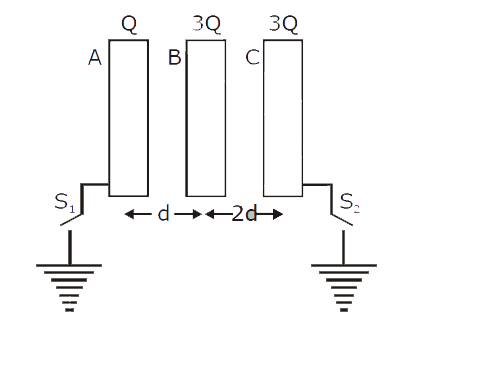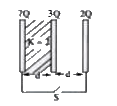Three identical parallel conducting plates A, B and C are placed as shown. Switches S1andS2 are open, and can connect A and C to earth when closed. +Q charges is given to B.

If S1is closed with S2 open, a charge of amount Q will pass through S1.
If instead S2 were closed with S1 open, a charge of amount Q will pass through S2.
If S1andS2 are closed together, a charge of amount 2Q/3 will pass through S2.
If S1andS2 are closed together, a charge of amount 2Q/3 will pass through S1, and a charge of amount Q/3 will pass through S2.
The correct Answer is:A, B, C
a.,b.,c.
When either A or C is earthed (but not both together), a parallel plate capcitor is formed withB, with ±Q charges on the inner surfaces. (The other plate, which is not earthed, plays no role.) Hence, charge of amount +Q flows to the earth. When both are earthedtogether, A and C effectively become connected. The plates now form two capacitors in paralle, with capacitances in the ration 1:2, and hence share charge Q in the same ratio.
C1=ε0A2d,C2=ε0AdC1C2=12
Now we can write
q1q2=C1C2=12
because potential difference of both the capacitors is same and q1+q2=Q.
Solving these, we get q1=Q/3,q2=2Q/3.

Topper's Solved these Questions
- MISCELLANEOUS VOLUME 3BOOK - CENGAGE PHYSICSCHAPTER - MISCELLANEOUS VOLUME 3EXERCISE - Assertion and Reason Type
8 Videos
- MISCELLANEOUS VOLUME 3BOOK - CENGAGE PHYSICSCHAPTER - MISCELLANEOUS VOLUME 3EXERCISE - Comprehension Type
94 Videos
- MISCELLANEOUS VOLUME 3BOOK - CENGAGE PHYSICSCHAPTER - MISCELLANEOUS VOLUME 3EXERCISE - True and False
3 Videos
- MECHANICAL PROPERTIES OF SOLIDSBOOK - CENGAGE PHYSICSCHAPTER - MECHANICAL PROPERTIES OF SOLIDSEXERCISE - Question Bank
4 Videos
- MISCELLANEOUS VOLUME 5BOOK - CENGAGE PHYSICSCHAPTER - MISCELLANEOUS VOLUME 5EXERCISE - Integer
12 Videos
Similar Questions
Three identical parallel conducting plates A, B and C are placed as shown. Switches S1andS2 are opened and connect A and C to earth when closed. +Q charge is given to B.

View SolutionThree large conducting plates A, B and C having charges +q,-2q and +q as shown in fig. The gaps l1andl2 are small and >l2 The plates A and C are fixed and B is free to move. Neglest gravity. If switch S is closed, the plate B will start moving towards

View Solution
Knowledge Check
Three long conducting plates A,B and C having charges +q,−2q, and +q as shown in figure. Here plate A and C are fixed. If the switch S is closed. The middle plate (B) will start moving in
 Aleftward directionBrightward directionCwill not moveDfirst move leftward and then rightward
Aleftward directionBrightward directionCwill not moveDfirst move leftward and then rightward
A,B and C are three large, parallel conducting plates, placed horizontally. A and C are rigidly fixed and earthed. B is given some charge. Under electrostatic and gravitational forces, B may beAin equilibrium midway between A and CBin equilibrium if it is close to A than to CCin equilibrium if it is closer to C than to ADB can never be the stable equilibrium.
Three identical conducting plates are arranged as shown in figure and they are given charges as indicated.When switch S is closed,the amount of charge flown through the switch is
View SolutionThree large plates A, B and C are placed parallel to each other and charges are given as shown. The charge that appears on the left surface of plate B is

View SolutionThree identical large metal plates each of area S are at distance dand2d from each other as shown. Metal plate A is uncharged, while metal plates BandC have charges +Qand−Q respectively. Metal plates A and C are connected by a conducting wire through a switch K. How much electrostatic energy is lost when the switch is closed ?

View SolutionThree identical metallic plates, each of area A, are kept at small separations as shown. Initially, charge Q, 3Q and 3Q are given to the plates A, B and c, respectively. Now, both the switches S1 and S2 are closed simultaneously. Then Charge flown through S1 and S2 are

View SolutionThree identical metallic plates, each of area A, are kept at small separations as shown. Initially, charge Q, 3Q and 3Q are given to the plates A, B and c, respectively. Now, both the switches S1 and S2 are closed simultaneously. Then Charge flown through S1 and S2 are

View SolutionThree large identical conducting plates are placed at a distance d in air. The space between the first two plates is filled completely with dielectric of dielectric constant 2 as shown. The plates are given charges 7Q,3Q and 2Q respectively. The outer plates are connected by good conducting wire through switch .S.. When .S. is closed, the charge that flows through switch is nQ Find the value of n?

View Solution
